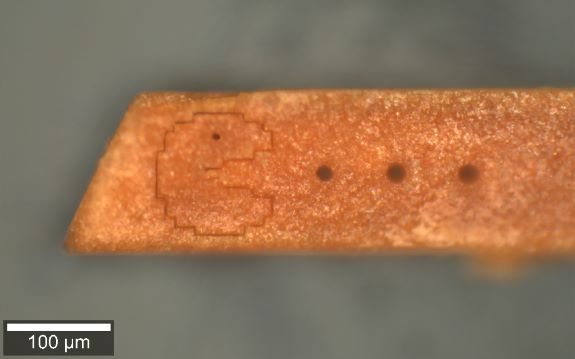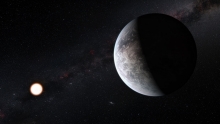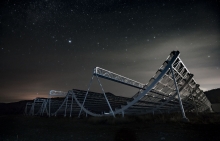Dr. Douglas Grant Stairs, Professor Emeritus in the Department of Physics at McGill University, passed away on February 19, 2023. He was 89 years old.


How do stars form in distant galaxies? Astronomers have long been trying to answer this question by detecting radio signals emitted by nearby galaxies. However, these signals become weaker the further away a galaxy is from Earth, making it difficult for current radio telescopes to pick up.

McGill University announced that six of its Professors (two individually, four as part of a multi-institutional team) have been declared winners of this year’s Natural Sciences and Engineering Research Council of Canada (NSERC) prizes. These prestigious awards range from individual awards for innovative discoveries by young researchers to recognitions of lifetime achievement and influence. The McGill-based recipients are as follows:

McGill undergraduates have a unique opportunity to expand their climate science literacy and acquire tools for taking action to reduce the impacts of the unfolding climate crisis.
Registration is now open to students in every program for FSCI 198: Climate Crisis and Climate Actions, a new undergraduate course featuring a team of multi-disciplinary instructors who will present diverse perspectives on the scientific and social dimensions of climate change.
- Faculty of Agricultural and Environmental Sciences
- Faculty of Arts
- Dept. of Atmospheric and Oceanic Sciences
- Dept. of Biology
- Dept. of Chemistry
- School of Computer Science
- Dept. of Earth and Planetary Sciences (EPS)
- Faculty of Education
- Faculty of Engineering
- Dept. of Geography
- Faculty of Law
- Dept. of Mathematics and Statistics
- Environment
- Desautels Faculty of Management
- Dept. of Physics
- Dept. of Psychology
- Redpath Museum
- Schulich School of Music
- Faculty of Science

Pac-Man carving by laser cutting. Credit: H. Borchers et al.
A gentler, more precise laser cutting technique
Laser cutting techniques are usually powered by high energy beams, so hot that they melt most materials. Now scientists from McGill University have developed a gentler, more precise technique using low-power visible light.

McGill University scientists have developed a new system for sharing the enormous amount of data being generated by the CHIME radio telescope in its search for fast radio bursts (FRBs), the puzzling extragalactic phenomenon that is one of the hottest topics in modern-day astronomy.

Milton Riaño, McGill’s Climate Change Artist-in-Residence, will curate the Faculty of Science’s Bicentennial Science/Art Exposition, billed as a “celebration of science in all its forms”.
The art show organizers are calling on all members of the McGill community to submit works in any medium, expressing what science means to them.
The deadline for submissions is October 31, 2021.
- Dept. of Anatomy and Cell Biology
- Art Exhibit
- Dept. of Atmospheric and Oceanic Sciences
- Bicentennial
- Dept. of Biochemistry
- Dept. of Biology
- Dept. of Chemistry
- School of Computer Science
- Dept. of Earth and Planetary Sciences (EPS)
- Dept. of Geography
- Dept. of Mathematics and Statistics
- Dept. of Microbiology and Immunology
- Dept. of Pharmacology and Therapeutics
- Dept. of Physics
- Dept. of Physiology
- Dept. of Psychology
- Redpath Museum
- Faculty of Science

The 5th edition of McGill Physics Hackathon brought together a record breaking number of participants in this 2020 online event.

Mini-Neptunes and super-Earths up to four times the size of our own are the most common exoplanets orbiting stars beyond our solar system. Until now, super-Earths were thought to be the rocky cores of mini-Neptunes whose gassy atmospheres were blown away. In a new study published in The Astrophysical Journal, astronomers from McGill University show that some of these exoplanets never had gaseous atmospheres to begin with, shedding new light on their mysterious origins.

The core mass of the giant exoplanet WASP-107b is much lower than what was thought necessary to build up the immense gas envelope surrounding giant planets like Jupiter and Saturn, according to a Canadian-led team of astronomers, including McGill University Professor Eve Lee.

The Faculty of Science is celebrating McGill’s 200th anniversary with a student art exhibition on the theme of “Science!”. McGill students at all levels and all faculties are invited to submit works in any medium, expressing what science means to them.
Faculty of Science bicentennial committee member, Torsten Bernhard, says the aim of the exhibition is to celebrate science in all its forms.
- Dept. of Anatomy and Cell Biology
- Art Exhibit
- Dept. of Atmospheric and Oceanic Sciences
- Dept. of Biochemistry
- Dept. of Biology
- Dept. of Chemistry
- School of Computer Science
- Dept. of Earth and Planetary Sciences (EPS)
- Dept. of Geography
- Dept. of Mathematics and Statistics
- Dept. of Microbiology and Immunology
- Dept. of Pharmacology and Therapeutics
- Dept. of Physics
- Dept. of Physiology
- Dept. of Psychology
- Redpath Museum
- Faculty of Science

The threshold for dangerous global warming will likely be crossed between 2027 and 2042 – a much narrower window than the Intergovernmental Panel on Climate Change’s estimate of between now and 2052. In a study published in Climate Dynamics, researchers from McGill University introduce a new and more precise way to project the Earth’s temperature. Based on historical data, it considerably reduces uncertainties compared to previous approaches.

A Canadian-led team of astronomers, including researchers from McGill University, has discovered that a repeating fast radio burst (FRB) originating from a nearby galaxy pulses at regular intervals.
Researchers within the Canadian Hydrogen Intensity Mapping Experiment (CHIME) Fast Radio Burst Collaboration used the CHIME telescope in British Columbia to show that the repeating radio source known as FRB 180916.J0158+65 – first discovered in 2018 by the same group - pulsates apparently every 16.35 days.

Crowdmark – an online grading tool developed especially to handle large classes – has been attracting a growing following across North America, with members of McGill’s own Faculty of Science among its most ardent enthusiasts. Kira Smith, reporter-at-large for the OSE, went undercover to find out more.

McGill University astrophysicist Matt Dobbs is the recipient of the 2019 Killam Research Fellowship in Natural Sciences.
The announcement was made today by the Canada Council for the Arts, which revealed this year's winners of the prestigious Killam Program, composed of the Killam Prizes and the Killam Research Fellowships.
